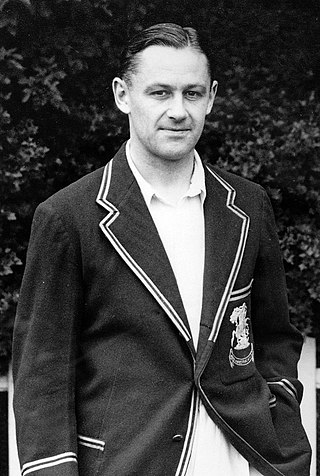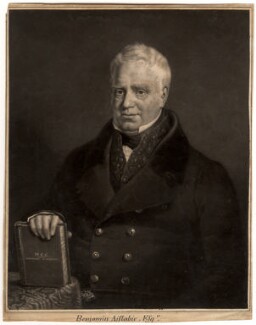First-class cricket, along with List A cricket and Twenty20 cricket, is one of the highest-standard forms of cricket. A first-class match is one of three or more days' scheduled duration between two sides of eleven players each and is officially adjudged to be worthy of the status by virtue of the standard of the competing teams. Matches must allow for the teams to play two innings each, although in practice a team might play only one innings or none at all.

Marylebone Cricket Club (MCC) is a cricket club founded in 1787 and based since 1814 at Lord's Cricket Ground, which it owns, in St John's Wood, London. The club was formerly the governing body of cricket retaining considerable global influence.

Lord's Cricket Ground, commonly known as Lord's, is a cricket venue in St John's Wood, London. Named after its founder, Thomas Lord, it is owned by Marylebone Cricket Club (MCC) and is the home of Middlesex County Cricket Club, the England and Wales Cricket Board (ECB), the European Cricket Council (ECC) and, until August 2005, the International Cricket Council (ICC). Lord's is widely referred to as the Home of Cricket and is home to the world's oldest sporting museum.

Christopher Dennis Alexander Martin-Jenkins, MBE, also known as CMJ, was a British cricket journalist and a President of MCC. He was also the longest serving commentator for Test Match Special (TMS) on BBC Radio, from 1973 until diagnosed with terminal cancer in January 2012.

Colonel George Robert Canning Harris, 4th Baron Harris,, generally known as Lord Harris, was a British colonial administrator and Governor of Bombay, best known for developing cricket administration via Marylebone Cricket Club (MCC).

Arthur Edward Robert Gilligan was an English first-class cricketer who captained the England cricket team nine times in 1924 and 1925, winning four Test matches, losing four and drawing one. In first-class cricket, he played as an amateur, mainly for Cambridge University and Sussex, and captained the latter team between 1922 and 1929. A fast bowler and hard-hitting lower order batsman, Gilligan completed the double in 1923 and was one of Wisden's Cricketers of the Year for 1924. When his playing career ended, he held several important positions in cricket, including that of England selector and president of the Marylebone Cricket Club (MCC). A popular figure within cricket, he was widely regarded as sporting and friendly.

Sir George Oswald Browning "Gubby" Allen CBE was a cricketer who captained England in eleven Test matches. In first-class matches, he played for Middlesex and Cambridge University. A fast bowler and hard-hitting lower-order batsman, Allen later became an influential cricket administrator who held key positions in the Marylebone Cricket Club (MCC), which effectively ruled English cricket at the time; he also served as chairman of the England selectors.
Anthony Robert Lewis CBE is a Welsh former cricketer, who captained England, became a journalist, went on to become the face of BBC Television cricket coverage between 1986 and 1998, and became president of the Marylebone Cricket Club (MCC).

Rachael Heyhoe Flint, Baroness Heyhoe Flint, was an English cricketer, businesswoman and philanthropist. She was best known for being captain of England from 1966 to 1978, and was unbeaten in six Test series: in total, she played for the English women's cricket team from 1960 to 1982. Heyhoe Flint was captain when her team won the inaugural 1973 Women's Cricket World Cup, which England hosted. She was also the first female cricketer to hit a six in a Test match, and one of the first ten women to become a member of the MCC.

Sir Edward Chandos Leigh was a British aristocrat of the Victorian era, a barrister by profession, and a first-class cricketer. He served as President of MCC for 1887–88.
In English cricket, the years 1826–1845 were dominated by the roundarm bowling issue, which was resolved when the style was legalised in 1835, and by the formation of the first modern county clubs between 1839 and 1845.
Sussex county cricket teams have been traced back to the early 18th century but the county's involvement in cricket dates from much earlier times as it is widely believed, jointly with Kent and Surrey, to be the sport's birthplace. The most widely accepted theory about the origin of cricket is that it first developed in early medieval times, as a children's game, in the geographical areas of the North Downs, the South Downs and the Weald.
1870 was the 84th season of cricket in England since the foundation of Marylebone Cricket Club (MCC). It was in many ways a bridge between two eras of the game and, in a summer comparable for hot and dry weather to 1887, 1911, 1976 or 1995, saw W.G. Grace for the second of three successive years establish a record run aggregate, late-blooming slow bowler James Southerton become the first bowler to take 200 first-class wickets in a season and the first use of the heavy roller at Lord's. Although the heavy roller had been patented several decades earlier, its use was never seriously considered by MCC management despite many protests over the danger posed by the Lord's pitch where extremely frequent “shooters” alternated with balls that “flew” over the batsman's head. These dangerous pitches were viewed as a symbol of virility by many amateur batsmen, however; though when remembering one of W.G.’s finest innings – 66 on one of the roughest Lord’s pitches against a very strong Yorkshire attack against Yorkshire – fast bowlers Freeman and Emmett wondered how the champion was not maimed or killed outright.
In the 1872 cricket season, the first experiment in pitch covering was carried out. Prince's Cricket Ground opened in Chelsea, London.
Cricket, and hence English amateur cricket, probably began in England during the medieval period but the earliest known reference concerns the game being played c.1550 by children on a plot of land at the Royal Grammar School, Guildford, Surrey. It is generally believed that cricket was originally a children's game as it is not until the beginning of the 17th century that reports can be found of adult participation.

Benjamin Aislabie was an English wine merchant, slave plantation owner and cricket administrator. He was the first Honorary Secretary of Marylebone Cricket Club (MCC) and was influential in its early development. He also played cricket between 1808 and 1841 as an amateur but was, statistically, one of the worst players on record.

George Wootton (1834–1924) was an English cricketer.

Cricket is a bat-and-ball game played between two teams of eleven players on a field at the centre of which is a 22-yard (20-metre) pitch with a wicket at each end, each comprising two bails balanced on three stumps. The batting side scores runs by striking the ball bowled at one of the wickets with the bat and then running between the wickets, while the bowling and fielding side tries to prevent this and dismiss each batter. Means of dismissal include being bowled, when the ball hits the stumps and dislodges the bails, and by the fielding side either catching the ball after it is hit by the bat, but before it hits the ground, or hitting a wicket with the ball before a batter can cross the crease in front of the wicket. When ten batters have been dismissed, the innings ends and the teams swap roles. The game is adjudicated by two umpires, aided by a third umpire and match referee in international matches. They communicate with two off-field scorers who record the match's statistical information.
Amateur status had a special meaning in English cricket. The amateur in this context was not merely someone who played cricket in his spare time but a particular type of first-class cricketer who existed officially until 1962, when the distinction between amateurs and professionals was abolished and all first-class players became nominally professional.
Through the Napoleonic Wars, county cricket virtually died as cricket was impacted by losses of investment and manpower.










